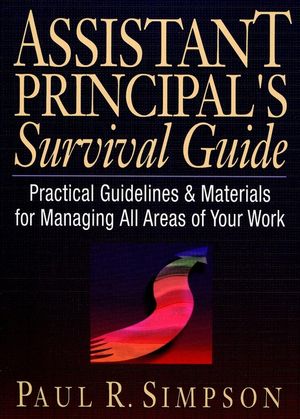Assistant Principal's Survival Guide: Practical Guidelines and Materials for Managing All Areas of Your WorkISBN: 978-0-13-086891-6
Paperback
304 pages
September 2000, Jossey-Bass
 This is a Print-on-Demand title. It will be printed specifically to fill your order. Please allow an additional 10-15 days delivery time. The book is not returnable.
|
||||||
Terminology in this resource.
SECTION 1.
The role of the assistant principal.
Being a leader.
Figure1-1 activities checklist.
Radical, risk taker, or leader?
Identifying and handling stress.
Looking toward the future.
Site-base management.
Enjoying the assistant principal position.
SECTION 2.
Gathering and communicating information.
Sources of information.
Filing of information.
Oral communication.
The telephone.
Use of the public address system.
Written communication.
Communicating information regarding students.
Figure 2-1 private driver permission form.
Figure 2-2 student trip: parent information and permission.
Figure 2-3 consent to photograph.
Administrative communications.
Calendars of upcoming social events.
Figure 2-4 weekly calendar of events interruptions.
Evaluation schedules.
Newsletters.
Reporting student progress to Parent/Guardians.
Figure 2-5 student progress report to parents.
Figure 2-6 student progress report.
Form letters and students.
Figure 2-7 form letter regarding student tardiness.
Figure 2-8 handwritten note to teachers following a student/parent conference.
Conducting conferences of interviews.
Staging the conference.
After the conference.
Role of the AP and guidance in interviewing students with multiple failing subjects.
Communication overload.
SECTION 3.
Creating a safe teaching/learning environment.
Physical safety.
Figure 3-1 authorization to pick up a child.
Intellectual safety.
Emotional safety.
Developing a good school atmosphere.
Figure 3-2a congratulatory/ thank you note to staff.
Figure 3-2b thank-you note for a staff contribution to the school.
Figure 3-3 congratulatory note to a student.
Students with problems who are likely to disrupt school.
Figure 3-4 student registration from.
Figure 3-5 letter to the student.
Figure 3-6 letter to the student's parents.
Figure 3-7 letter to the student's sponsor.
Figure 3-8 handwritten note to teachers.
Minimizing violence in the school.
SECTION 4.
School discipline.
Education system.
Teachers.
Students.
Student tardiness and absence.
Figure 4-1 notification of student discipline.
Tardiness.
Absence.
Figure 4-2 letter to parent/guardian regarding a family vacation.
Therapeutic withdrawal, suspension, and expulsion of students.
Therapeutic withdrawal.
Suspension.
Truancy.
Figure 4-3 letter to a parent regarding suspension of a student.
Expulsion.
Students who drop out.
Students who drift out .
Students who make their own decision to leave.
Students who are forced out.
Figure 4-4 student withdrawal form.
Figure 4-5 letter to a student forced to leave school.
SECTION 5.
Working together.
The community.
Students.
Student council.
The police officer.
Parents and the school.
Figure 5-1 suggestions to help your child become a positive learner.
Parent and student groups.
Parents' night.
Utilizing outside agencies.
Figure 5-2 back to school event.
The school library and the assistant principal.
Figure 5-3 student access to the internet.
Figure 5-4 loan of school equipment.
Figure 5-5 theft or vandalism of student property or school property on loan to a student.
SECTION 6.
Curriculum and the assistant principal.
Special education.
Curriculum and a master schedule or school timetable.
Building a master schedule or school timetable.
Using a prepared course selection schedule or timetable.
Figure 6-1 partial course selection schedule.
SECTION 7.
Monitoring student progress.
Establishing a monitoring process.
Figure 7-1 student record.
Figure 7-2 internal progress report.
Figure 7-3 daily monitoring of student effort and achievement.
Entries form other schools.
Figure 7-4 letter to parents/guardians when a student lacks proper prerequisites.
Student evaluation.
Student testing schedules.
Figure 7-5 missed evaluation report.
Student exemption from formal evaluations.
SECTION 8.
Student perspectives.
The impact of friends.
Student concerns.
The school office.
Contracts with students and form letters.
Students writing their own notes.
Figure 8-1 student permission to write own notes.
Cooperative education.
Student mentoring.
Figure 8-2 mentor application and profile.
Figure 8-3 declaration of intent.
Figure 8-4 driver's insurance declaration.
Figure 8-5 response of the applicant's physician.
Figure 8-6 response of the applicant's employer/supervisor.
Figure 8-7 response of the applicant's spouse/companion/relative/friend.
Figure 8-8 parent permission for mentoring.
Figure 8-9 protégé/ student application and profile.
Figure 8-10 mentor and protégé pledge.
Alternative programs.
SECTION 9.
Assistant principal interactions.
Teachers.
Beginning teachers.
Substitute teachers.
Figure 9-1 teacher-initiated request for classes to be covered.
Figure 9-2 lesson instructions for substitute teachers—high school.
Figure 9-3 lesson instructions for substitute teachers—elementary school.
Teachers experiencing difficulties.
Figure 9-4 substitute teacher feedback—high school.
Figure 9-5 substitute teacher feedback—elementary school.
Teacher evaluation.
Principal.
Figure 9-6 cover sheet for performance evaluation criteria.
Figure 9-7 background information and being professional.
Figure 9-8 teacher performance appraisal.
Figure 9-9 criterion—knowledge of the subject material and various teaching methodologies.
Figure 9-10 criterion—knowledge of the learner.
Figure 9-11 criterion—knowledge of the curriculum.
Figure 9-12 criterion—knowledge of the learner.
Figure 9-13 criterion—knowledge of the organization.
Figure 9-14 criterion—skills in planning and preparation.
Figure 9-15 criterion—skills in class management.
Figure 9-16 criterion—skills in communication.
Figure 9-17 criterion—skills in teaching techniques.
Figure 9-18 criterion—professional behaviors and memberships.
Superindentent/trustee.
SECTION 10.
Legal Issues.
Recommendations for avoiding legal problems.
Figure 10-1 student behavior at school sponsored events.
Some situations involving the assistant principal.
Illness and injury to students or staff.
Inebriated students.
A bomb in the school.
Horseplay.
Violent incidents.
Liability insurance.
Figure 10-2 violent incident report.
Figure 10-3 record of suspected child abuse.
School-sponsored programs.
Serving the needs of a divers population.
Figure 10-4 parental permission for athletic participation.
Figure 10-5 medical form for athletic participation.
Summary.
Glossary of terms.
List of reproducibles.
List of anecdotes.
Index.



